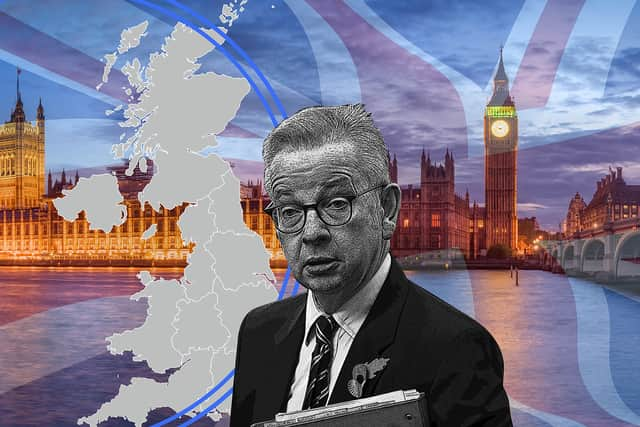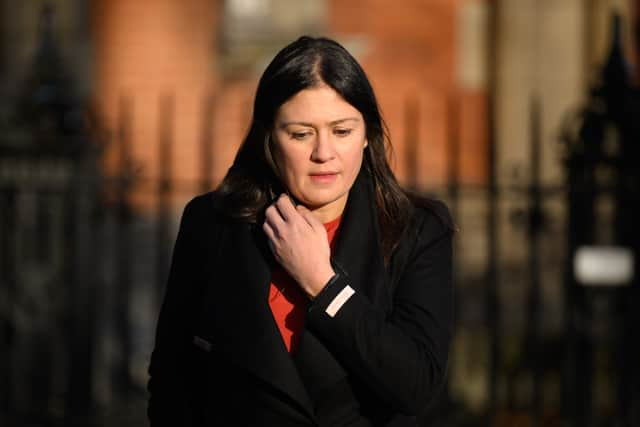Levelling Up White Paper 2022: what are government’s 12 missions set out by Michael Gove - and what is fund?
and live on Freeview channel 276
Boris Johnson is promising to break the link between “geography and destiny” as the government publishes its long-awaited blueprint for “levelling up” the country.
The white paper will set out a series of wide-ranging national “missions” – from improving public transport to ensuring access to 5G broadband – to be enshrined in law.
Advertisement
Hide AdAdvertisement
Hide AdAt the same time, ministers are promising to provide more power to the regions in a “devolution revolution” with the offer of a London-style deal for any area of England that wants one.
Labour however dismissed the plan as “more slogans” with “few new ideas”.
The promise to “level up” forgotten and deprived communities was a key theme of Prime Minister Boris Johnson’s 2019 general election campaign which saw the Tories make huge gains in Labour’s previously impregnable “red wall” heartlands.
Levelling Up Secretary Michael Gove, the architect of the plan who will be responsible for driving through the changes, said it would end a “historic injustice”.
Advertisement
Hide AdAdvertisement
Hide AdSo, what are the 12 plans the government claim to achieve by 2030 - and how will they be funded?


What are the 12 ‘Missions’ to Level Up the UK?
In all, the White Paper includes 12 national “missions” to be achieved by 2030 to be enshrined in a a flagship Levelling Up and Regeneration Bill.
1. Pay, employment and productivity will have risen in every area of the UK, with each containing a globally competitive city, with the gap between the top performing and other areas closing.
2. Domestic public investment in Research & Development outside the Greater South East will increase by at least 40% and at least one third over the Spending Review period, with that additional government funding seeking to leverage at least twice as much private sector investment over the long term to stimulate innovation and productivity growth.
Advertisement
Hide AdAdvertisement
Hide Ad3. Local public transport connectivity across the country will be significantly closer to the standards of London, with improved services, simpler fares and integrated ticketing.
4. The UK will have nationwide gigabit-capable broadband and 4G coverage, with 5G coverage for the majority of the population.
5.The number of primary school children achieving the expected standard in reading, writing and maths will have significantly increased. In England, this will mean 90% of children will achieve the expected standard, and the percentage of children meeting the expected standard in the worst performing areas will have increased by over a third.
6. The number of people successfully completing high-quality skills training will have significantly increased in every area of the UK. In England, this will lead to 200,000 more people successfully completing high-quality skills training annually, driven by 80,000 more people completing courses in the lowest skilled areas.
Advertisement
Hide AdAdvertisement
Hide Ad7. The gap in Healthy Life Expectancy (HLE) between local areas where it is highest and lowest will have narrowed, and by 2035 HLE will rise by 5 years.
8. Well-being will have improved in every area of the UK, with the gap between top performing and other areas closing.
9. Pride in place, such as people’s satisfaction with their town centre and engagement in local culture and community, will have risen in every area of the UK, with the gap between the top performing and other areas closing.
10. Renters will have a secure path to ownership with the number of first-time buyers increasing in all areas; and the government’s ambition is for the number of non-decent rented homes to have fallen by 50%, with the biggest improvements in the lowest performing areas.
Advertisement
Hide AdAdvertisement
Hide Ad11. Homicide, serious violence, and neighbourhood crime will have fallen, focused on the worst-affected areas.
12. Every part of England that wants one will have a devolution deal with powers at or approaching the highest level of devolution and a simplified, long-term funding settlement.
Where is the funding coming from?
There has been speculation this morning from Labour over whether the money for the Levelling Up agenda is fresh funding or “rehashed”.
Lots of money has been promised but it’s not clear in the government’s latest announcement directly where sources of cash are coming from.


Advertisement
Hide AdAdvertisement
Hide AdSpeaking on LBC, Michael Gove said: “There’s a difference between Rishi (Sunak) announcing that he’s going to give me money and me spending it.
“But if you are in Wolverhampton or Sheffield, and you’re getting new cash to invest in your city centre, that is new money.”
But his Labour counterpart, Lisa Nandy, criticised the Levelling Up White Paper as being a “series of rehashed announcements, some of which are so old they were actually originally made by Gordon Brown when he was the Labour prime minister in 2008”.
A message from the editor:
Thank you for reading. NationalWorld is a new national news brand, produced by a team of journalists, editors, video producers and designers who live and work across the UK. Find out more about who’s who in the team, and our editorial values. We want to start a community among our readers, so please follow us on Facebook, Twitter and Instagram, and keep the conversation going. You can also sign up to our newsletters and get a curated selection of our best reads to your inbox every day.
Comment Guidelines
National World encourages reader discussion on our stories. User feedback, insights and back-and-forth exchanges add a rich layer of context to reporting. Please review our Community Guidelines before commenting.
